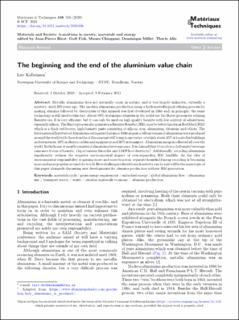| dc.description.abstract | Metallic aluminium does not naturally occur in nature, and it was largely unknown, virtually a mystery, until 200 years ago. The modern aluminium production using a hydrometallurgical refining process for making alumina followed by electrolysis of this mineral was first developed in 1886 and, in principle, the same technology is still used to this day. About 90% of alumina refineries in the world use the Bayer process for refining Bauxite ore. It is very efficient, but it can only be used on high quality bauxite with low content of admixtures, especially silicon.The Bayer process also generates a BauxiteResidue (BR),maybe better known asRedMud (RM) which is a thick red-brown, high-basicity paste consisting of silicon, iron, aluminium, titanium and others. The International Institute of Aluminium estimates that since 1886 almost a billion tonnes of aluminium were produced around the world with three fourths of this amount still being in use today, of which about 35% is located in buildings and structures, 30% in electric cables and equipment and 30% in transport.Aluminium scrap is collected all over the world. In the home, it mostly consists of aluminium beverage cans. It is claimed that 1 ton of recycled empty beverage cans save 8 tons of bauxite, 4 kg of various fluorides and 14 kWh of electricity1. Additionally, recycling aluminium significantly reduces the negative environmental impact of ever-expanding RM landfills. As the idea of environmental responsibility is gaining more and more traction, separate household scrap recycling is becoming more and more popular around the world. How challenges related to such activity can be met will be the main topic of this paper alongside discussing new developments for alumina production without RM generation. | en_US |

